Front Street and Alexander
Coupeville, Washington
Blockhouse / Hotels / Island County Historical Society, Archives and Museum
Quote from The Historical
Marker Database.
The Alexander Block house is one of four blockhouses remaining in Central Whidbey Island. Few original blockhouses of this type remain throughout the United States. John Alexander, Sr. built this blockhouse on his donation land claim in about 1855 to guard against Native American attack during the wars of 1855-1857. It may have been used instead as a "root cellar".
The exact original location is unknown - during the 1930s, the structure was purchased by local residents and was moved from its original location on the John Alexander farm to its present location next to the Island County Historical Museum. The blockhouse has retained its physical and historic character and integrity, making it a popular tourist attraction and educational opportunity for many decades.
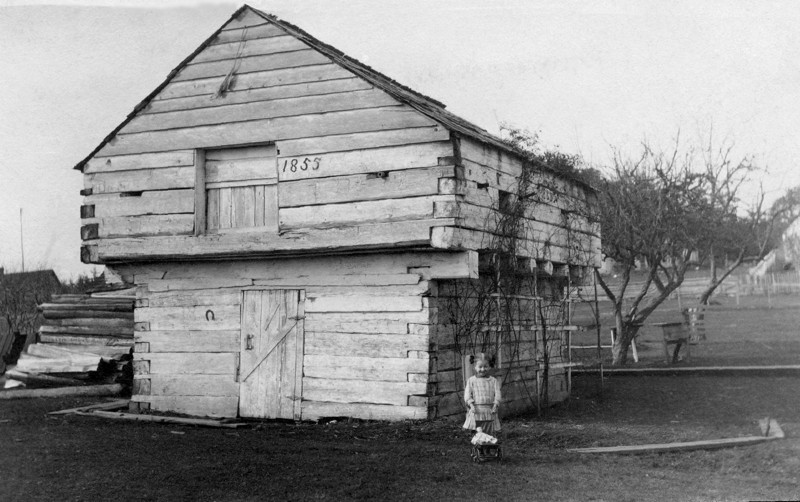
Blockhouse at original site
Courtesy: Private collection of Lillian Huffstettler
Quote from the Ebey's Landing Building Inventory:
In the 1930's, the structure was purchased by local residents, moved to its present location and reconstructed. The structure was disassembled with the logs numbered, the two bottom logs were replaced and the structure was reassembled on a concrete foundation. The Coupeville Lion's Club built the Canoe House used to display 3 Indian canoes.
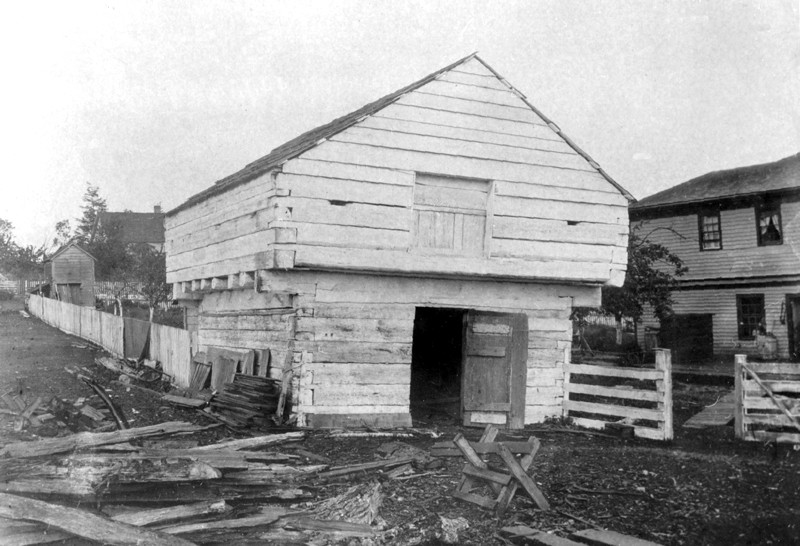
Coupeville block house after being moved next to the Hotel - 1895.
Courtesy: Island County Historical Museum, Coupeville
Quote from "A Particular Friend, PENN'S COVE" by Jimmie Jean Cook.
On February 26, 1853, Humphrey and Nathaniel Hill had assisted the Alexanders in raising their first house. One source says that this building was on the part of the claim sold to Hill Harmon, that is, near Prairie Center. The other source says that it was near the present Alexander Blockhouse. In any event, this was the home used by the commissioners for their first meeting in Island County Oregon Territory. On November 15, 1856, Colonel Ebey helped raise the second house and there is no doubt that this was on the site near the blockhouse.
Abram Alexander married Grace B. Wilkins on May 24, 1878, and they lived in the hotel which was known at various times as the State, the Pioneer, the Starwana, and the Blockhouse Inn, but was originally known as Mother Fay's Hotel. It had opened for business in 1870. In 1852 Mrs. Alexander had written "Captain Bell has sold out his merchandise to Mr. A." The Hills bought merchandise from the Alexanders.
In 1884 the Island News printed, "I almost forgot to mention Mr. A. Alexander in his capacity as mine host of the Coupeville Pioneer hotel. This house has stood alone as the hotel of Coupeville for many years, until the past year or two, and was known all over the Sound as Mother Fay's Hotel where the old-timers used to gather and get the squarest meal on the island. But age has overtaken Mrs. Fay and the house has passed into the hands of her son, A. Alexander, who continues to manage the hotel. All who want a nice clean and quiet hotel will find it at Mr. Alexander's and will get as good accommodations as is usually found in hotels."
In 1890 the San de Fucan said, "The State Hotel, under the management of Mr. Alexander, is an exceedingly handsome structure. The hotel is now receiving a coat of paint, and is being thoroughly renovated throughout. Mr. Alexander sets a good table and is a popular and accommodating host. The State is a very home-like hotel and is well-patronized. Mr. Alexander's is a good hotel to stop at."
1856 - The Alexanders built a house on the location of the current museum.
1870 - After the death of Mr Alexander, his wife opened "Mother Fay's Hotel", it later became the Pioneer Hotel.
The business of cutting logs and timber and shipping them to California was brisk and several sea captains in this business settled here. During this time a group of the sea captains who regularly met in the hotel decided that the new settlement needed a name. They placed their names in a hat. One was drawn out, that of Captain Thomas Coupe, and from then the place was known as Coupeville.
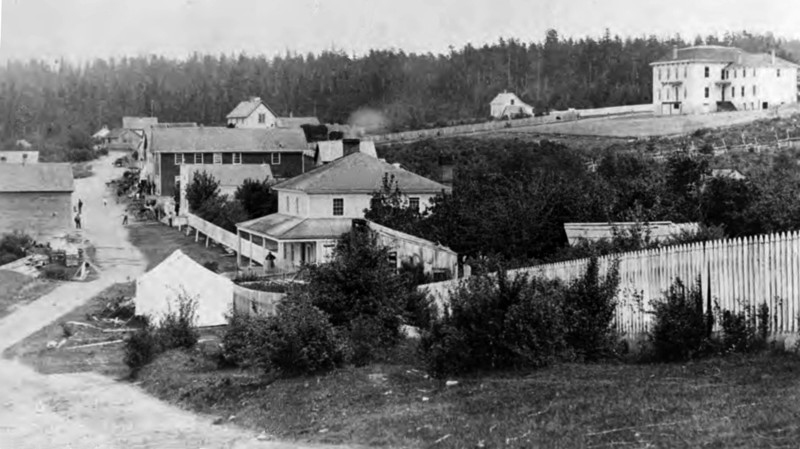
The Pioneer Hotel (foreground) around 1884
Courtesy: Whidbey Island Historical Musem, Coupeville.
1889 - The Hotel was renamed the State Hotel to commemorate Washington becoming a state.
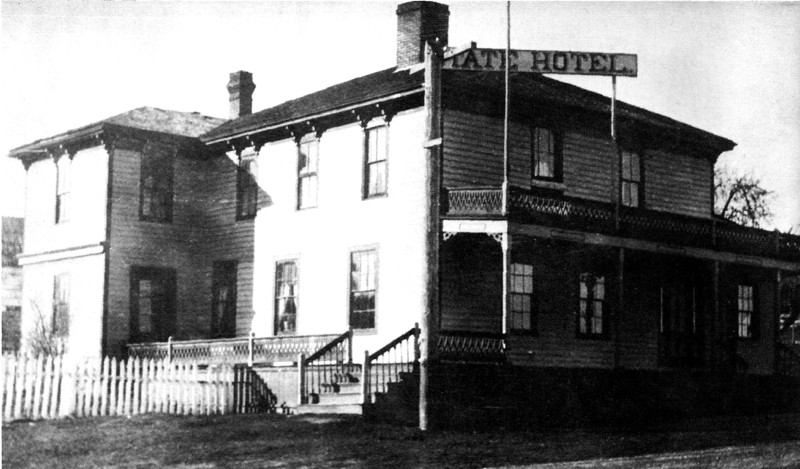
The State Hotel
Courtesy: "A Particular Friend, PENN'S COVE" by Jimmie Jean Cook.
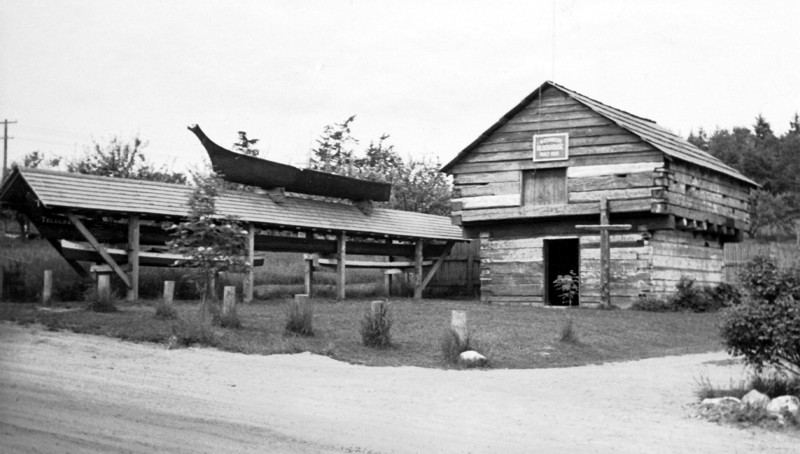
Coupeville block house with canoes and cross
Courtesy: Private collection of Lillian Huffstettler
The hotel changes its name to Starwana
*From an interview by Judy Lynn with Joanne Engle Brown in 2008.
Alva Wannamaker married Harry Starks which is how the Starwana Hotel got its name. [Note: The Starwana Hotel was where Island County Museum is now.] I don’t know who built it. Elva and Harry operated it as a hotel. They started a hot lunch program at school when I was in the 8th grade. Alva was the first cook for that program. She taught Home-Ec. Elva died in 1950 in the middle of my sophomore year.
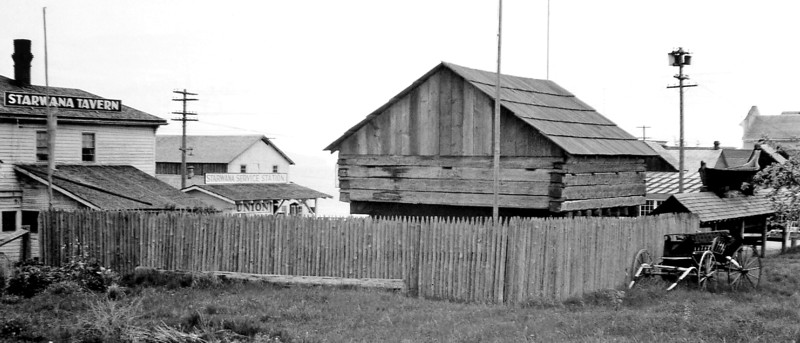
Starwana Hotel, service station and blockhouse from the west
Courtesy: Judy Lynn
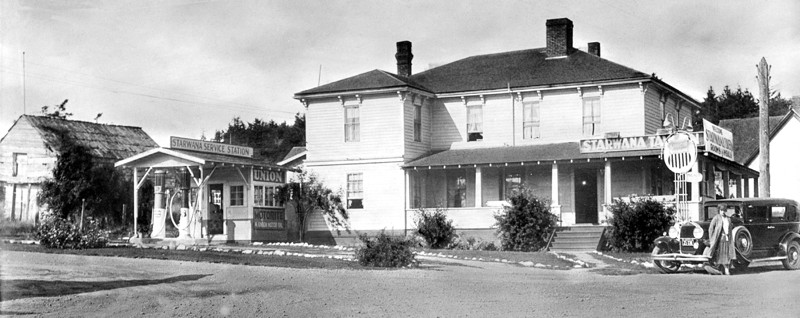
Starwana Hotel, service station and blockhouse from the east
Courtesy: Island County Historical Museum, Coupeville
*Quote from A Trenton NJ paper, March 26 1961.
FAMOUS AMERICAN TAVERNS
Because a wandering peg legged Irishman knew a snug harbor when he saw one, the Blockhouse Inn on Washington’s Whidbey Island, north of Seattle, is celebrating its hundredth anniversary.
John Alexander trekked in 1852 with his family by covered wagon across the United States, then by boat to Whidbey, the nation’s second largest coastal island. In a crook of the island’s long arm, Alexander came to a natural deep-water harbor, fringed by tall fir trees, lace like ferns and lush grass and populated by browsing deer.
There were Indians, too. They looked friendly, but the Irishman wasn’t taking a chance. He built a sturdy blockhouse, complete with rifle slits. It stood always ready as Alexander busied himself with cutting timbers for California’s flourishing gold mines. Later he built a two story, ten-bedroom house, with four brick fireplaces. The house overlooked the port, where four masted schooners [barks] tied up to load Alexander’s timbers.
After Alexander died in 1860, his widow turned the house into an inn, which it has been ever since. It was a restful place for the early sea captains where they could sip ale, dine on venison teak, and watch their ships riding safely at anchor.
All that was needed was to give the harbor a name. A group of captains therefore one day placed their own names in a hat. One was drawn out, that of Captain Thomas Coupe, and thereafter the place was known as Coupeville.
Today sailing men still dock at Coupeville to dine at the friendly inn beside the old blockhouse. And many tourists travel to the island by ferry.
*From an interview by Judy Lynn with Diane and Roger Eelkema, 2009.
Diane: I remember when the Starwana Hotel, across from Lindsay’s Grocery Store [now Mariners Court] burned. It had a big front porch with rocking chairs. They had a sailboat model in the window with canvas sails. I don’t remember going in the hotel.
....
Roger: I remember the McPherson’s building as Fred Moore’s paint store. He was a nice guy. There were gallons of paint, thinner, and kerosene. There was a huge fire that caused him to go out of business. The Navy sent pumper trucks and they pumped water out of the bay. Pumper trucks were also sent from the Navy when the Starwana Hotel burned. It was a hard fire to put out. There was not much damage upstairs but afterward there was a lot of black soot. It was a big deal – everybody was sorry. Fred had a boat, The North Wind. He lived on the Moore Place off Parker Road.
The hotel changed its name to the Blockhouse Inn and lost the service station. Date unknown.
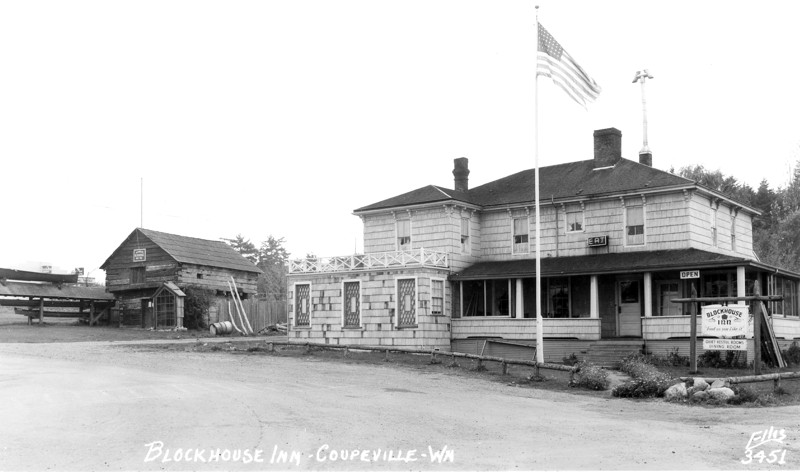
Blockhouse Inn
Courtesy: Judy Lynn
*From a paper published in Trenton, N.J. on Sunday, March 26, 1961
FAMOUS AMERICAN TAVERNS
Blockhouse Inn, Whidbey Island, Wash.
Because a wandering peg-legged Irishman knew a snug harbor when he saw one, the Blockhouse Inn on Washington’s Whidbey Island, North of Seattle, is celebrating its hundredth anniversary.
John Alexander trekked in 1852 with his family by covered wagon across the United States, then by boat to Whidbey, the nation’s second largest coastal island. In a crook in the island’s long arm, Alexander came to a natural, deep water harbor, fringed by tall fir trees, lace-like ferns and lush grass and populated by browsing deer.
There were Indians too. They looked friendly, but the Irishman wasn’t taking chances. He built a sturdy blockhouse, complete with rifle slits. It stood always ready as Alexander busied himself with cutting timbers for California’s flourishing gold mines. Later he built a two story, ten bedroom frame house, with four brick fireplaces. The house overlooked the port, where four masted schooners tied up to load Alexander’s timbers.
After Alexander died in 1860, his widow turned the house into an inn, which it has been ever since. It was a restful place for the early sea captains where they could sip ale, dine on venison steak, and watch their ships riding safely at anchor.
All that was needed was to give the harbor a name. A group of captains therefore one day placed their names in a hat. One was drawn out, that of Captain Thomas Coupe, and therefore the place was known as Coupeville.
Today sailing men still dock at Coupeville to dine at the friendly inn beside the old blockhouse. And many tourists travel to the island haven by ferry.
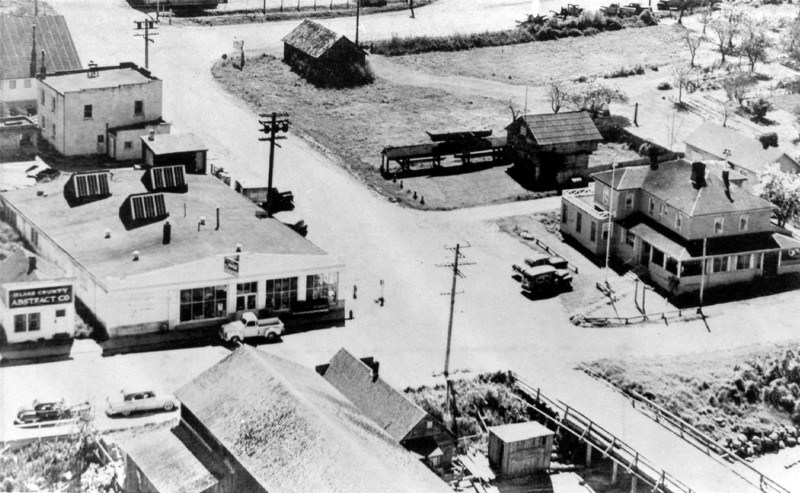
Blockhouse Inn from the air
Courtesy: Ebey's Landing National Historic Preserve
*From an interview by Judy Lynn with Ilah Engom, 2009.
Ilah: I was born on Camano Island on November 1, 1922. I was 16 when we moved to Coupeville in 1939. The County Assessor had passed away and my father, Ralph Lindsay, was appointed Assessor in 1937 or 1938. We had a 240 acre ranch on Camano. My dad stayed at the Starwana Hotel until we sold the ranch. The Starwana was owned by Jack and Helen Williams. Her niece, Lorraine Lodding, gave me a cut glass bowl that had been in the Starwana. [The bowl was on her coffee table.] She and her husband lived in the Calhoun apartments.
....
Judy: What do you remember about the Starwana Hotel?
Ilah: I was only in it a couple of times. It was a nice hotel. I know one time, after 1970, when we were living in a house next to Hesselgrave’s we saw an airplane come up the boat ramp. Roy drove down there thinking they might be having problems. They were coming to Seattle but wondered if there was hotel. He drove them to the Starwana. In 1942 or 1943 Mrs. William’s niece, Lorraine Loddy, worked at the Starwana.
*From an interview by Judy Lynn with Charles Lindsay in 2009
Jack Williams and his wife, Marian, owned the [Blockhouse Inn] hotel, on Alexander. He drove a 1955 black Cadillac limo. He was an excellent chef. He died and his wife never ran the hotel after that, but apparently she stayed there. The story was the fire started in the kitchen. Her daughter lived in California and came up and got her.
*From an interview by Judy Lynn with Dorothy Lindsay in 2009
The Blockhouse Inn was an old hotel and one night caught fire. I had gotten some dishes salvaged from there.
1968 - The Blockhouse Inn burned down.
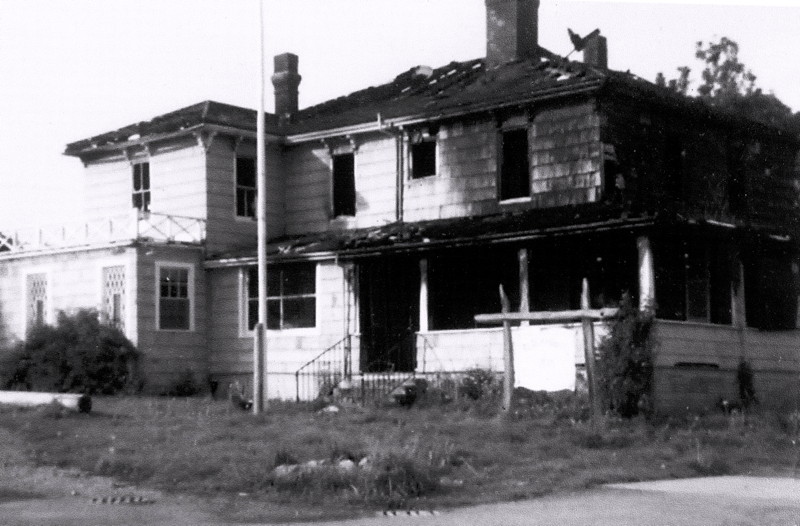
The Blockhouse Inn after the fire
Courtesy: Private Collection of Peggy Darst.
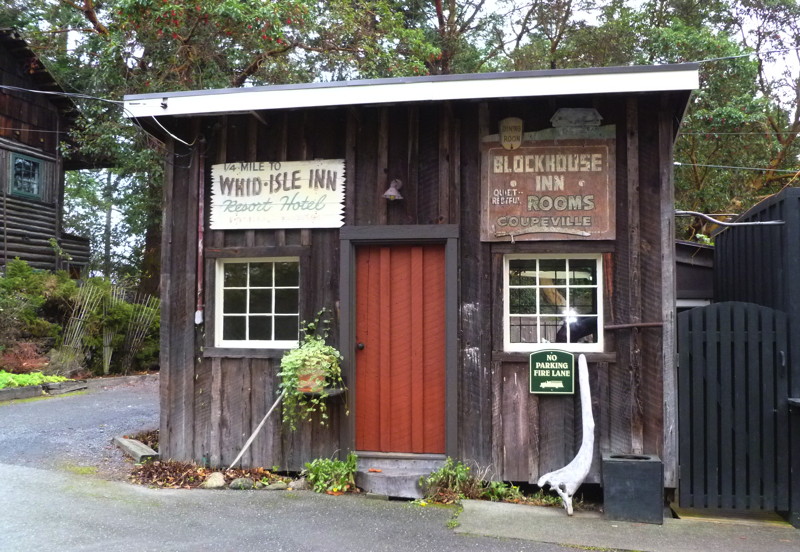
The Blockhouse Inn sign now can be found at the Captain Whidbey Inn on Penn's Cove
Courtesy: Robert Y Elphick, 2013
1986 - The Island County Historical Society purchased the land and built the current building in 1989.
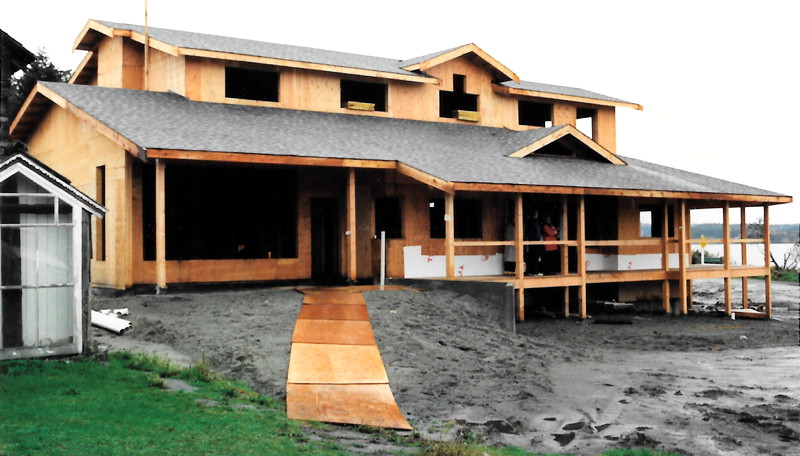
The museum under construction.
Courtesy: Judy Lynn
In July 1991, the Island County Historical Society Museum was opened to the public.
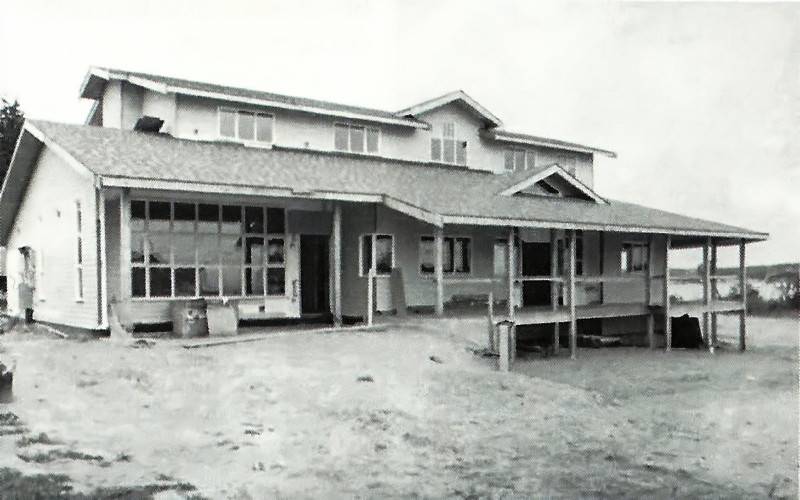
The museum Completed.
Courtesy: Island County Historical Museum, Coupeville
*From the Island Heritage News, 3rd Quarter 2016
This Year Marks the Museum's 25th Anniversary
On July 19,1991, the expertly hand-carved doors (by Glen Russell) of the ICHS new museum were officially opened to the public. The opening ceremony that day began with Murriel Short (Museum
Director) ringing the San De Fuca school ball donated by the Armstrong Family. Bud Merryman (ICHS Board President) offered acknowledgments, and Masters of Ceremony speakers included Dick Caldwell (Island County Commissioner), Alan Hancock (Superior Court Judge), Rick Caldwell (Head Librarian MOHI Museum), and Dorothy Nell (Historian & Author) who also conducted the ribbon cutting.
However, our 7,200 square foot, three-story museum facility had been previously dedicated November 11, 1989, on Washington State's 100th Anniversary. Master of Ceremonies that day, Wallie Funk, stated the museum "represents a dream of more than half a century ... The community should really be proud of it." Dignitaries present were: State Representative Mary Margaret Haugen, Commanding Officer of NAS Whidbey Capt. Barry Sehlin, Congressman Al Swift,
The new facility was planned 5 years prior in order to allow the ICHS to continue to provide a county history museum as they were not only at the end of their lease in their current location, but also running out of space. The community came together in a BIG way on this project. Many goods and services were donated and volunteers spend countless hours on the project.
Architects were Bassetti, Norton, Metler & Rekevics of Seattle.
US Navy volunteers dedicated over 1,000 hours of labor, spearheaded by substantial hours by Wayne Yarndl who was then an aviation machinist stationed at NAS Whidbey. Island
Construction, Everett Brothers, and Concrete Nor'west donated concrete. Frontier Industry of Anacortes donated exterior doors, Phil Smoots of Kreig Construction first broke ground with his bulldozer and the company also assisted with moving lumber around the site along with Larry Fournier of Lumber Jack's - in fact, two tractor-trailers full of lumber donated by Plum Creek Timber Co. of Montana.
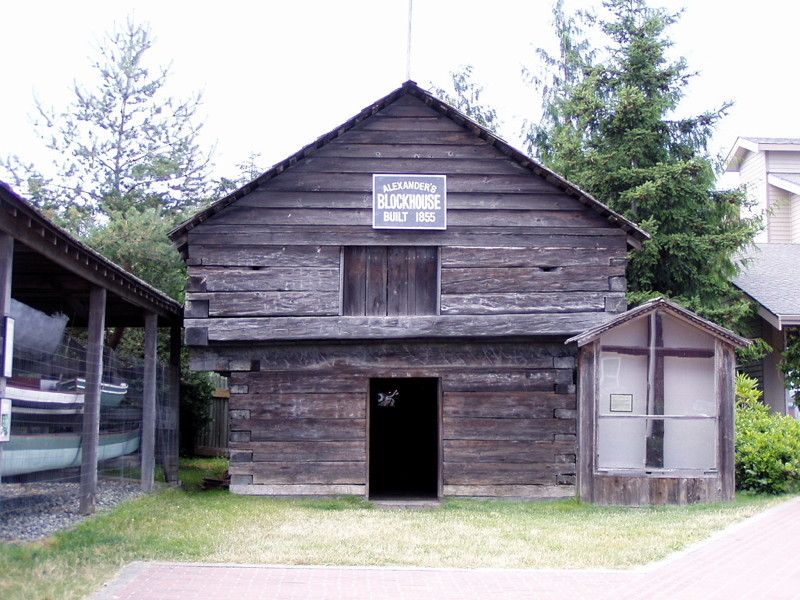
The Alexander Block House next to the Museum. Note that the cross is now in a protective case.
Courtesy: Robert Y Elphick, 2004
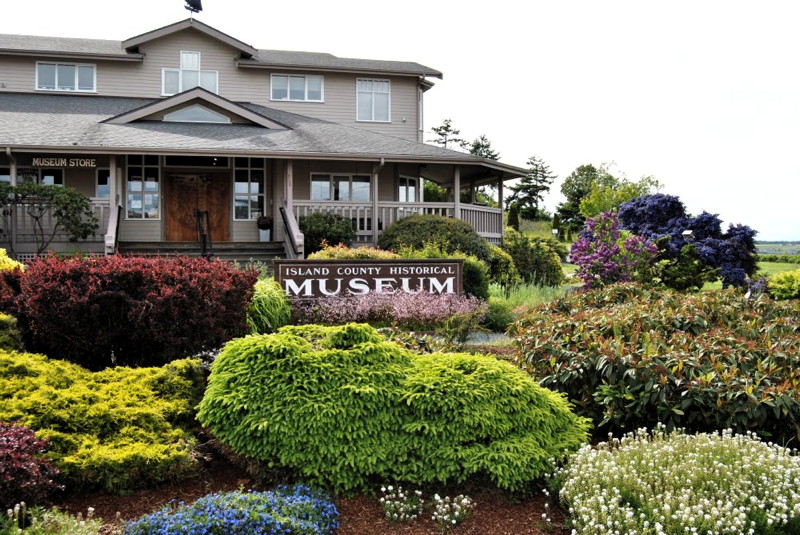
Island County Historical Museum, Coupeville
Courtesy: http://www.whidbeycamanoislands.com.
2013 - The Blockhouse was renovated to replace rotten wood. The Lions Club volunteers were led by Harrison Goodall, an Island County renovation expert.
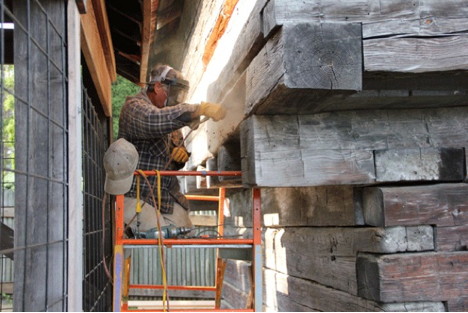
A member of the Central Whidbey Lions Club volunteers his time and talent to help preserve the Alexander Blockhouse at the Island County Historical Society and Museum. The museum was awarded a matching grant from the Ebey’s Forever Fund for the restoration project.
Courtesy: Elisabeth Murray, Whidbey Examiner
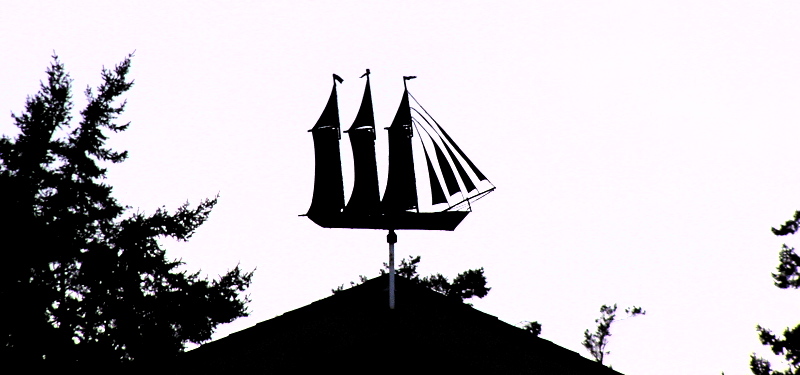
WEATHER VANE
The weather vane sitting atop the museum is a simplified replica of Captain Thomas Coupe's barque. It's made of galvanized steel, took over 100 hours to create and was donated to the museum by the craftsperson (who preferred to remain anonymous) as a place appropriate for its infinite "sailing". It's a treasured jewel topping the museum and has become the museum logo.
Courtesy: Robert Y Elphick, 2005
* All the interviews are extracted from the Judy Lynn's Oral History Project. Judy Lynn interviewed everyone she could find who had any memories of the history of Front Street. For more information on the project contact the Whidbey Island Historical Musem, Coupeville.
The e-book Front Street, Coupeville - An Oral History by Judy Lynn contains all the interviews. It can be purchased for $9.99 at Amazon.com for Kindle application or device or from the Apple Store for iBooks applications. Proceeds go to the Island County Historical Society.


